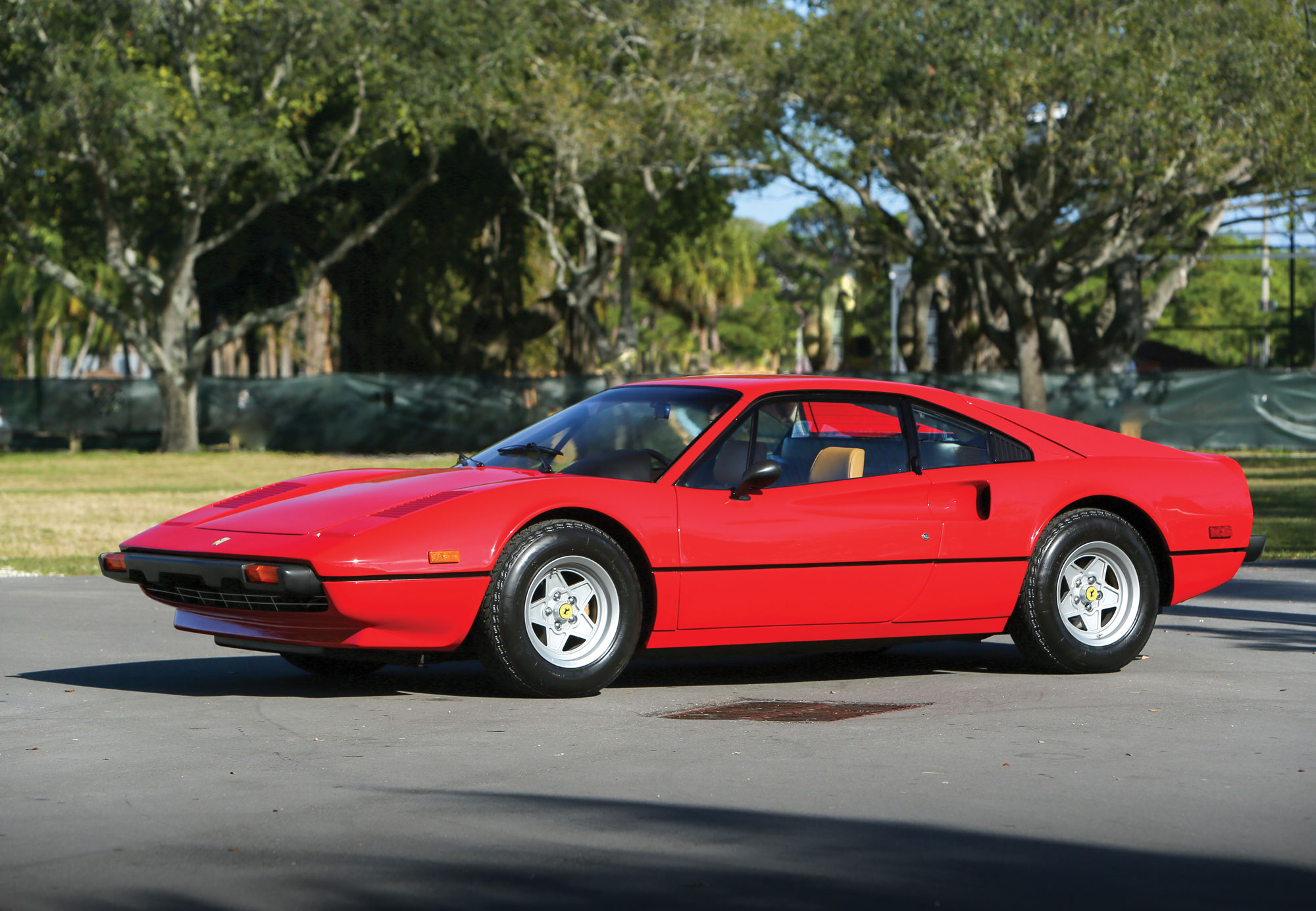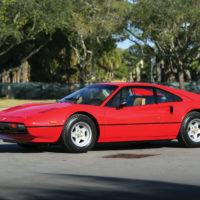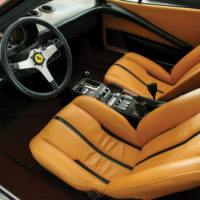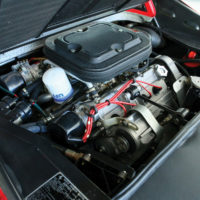SCM Analysis
Detailing
| Vehicle: | 1976 Ferrari 308 GTB “Vetroresina” |
| Years Produced: | 1975–77 |
| Number Produced: | 712 |
| SCM Valuation: | $163,000 |
| Tune Up Cost: | $3,500 |
| Chassis Number Location: | Data plate in driver’s door jamb |
| Engine Number Location: | In the “V” on the driver’s side |
| Club Info: | Ferrari Club of America |
| Website: | http://www.ferrariclubofamerica.com |
| Alternatives: | 1970–76 Lamborghini Jarama, 1976–78 Lotus Esprit, 1974–77 Porsche 911S |
| Investment Grade: | C |
This car, Lot 153, sold for $173,600, including buyer’s premium, at RM Sotheby’s Amelia Island auction on March 5, 2022.
The 246 Dino had been a big hit for Ferrari in the early 1970s, but escalating federal safety and emission standards put a nail in its coffin. Meeting the new 5-mph bumper standards required a new body design, and increased displacement would be needed to deliver Ferrari performance from an engine choked by emission equipment.
Beyond the Dino
Ferrari was not going to import its Berlinetta Boxer to the U.S., which meant the new model would be the flag bearer for the marque. It would also have to be a notch up in quality. Dinos were well built, but not up to Ferrari GT standards.
The Dino 308 GT4 was introduced to meet the need. The GT4 featured a 3.0-liter quad-cam V8 with four Weber carbs. It was a wonderful driver, but its 2+2 configuration and Bertone body were not right for a halo model. Ferrari needed another hit, so it looked to Pininfarina for salvation.
Leonardo Fioravanti was just 26 years old when he joined Pininfarina. He would stay there for the next 26 years and have a hand in the design of the 206 and 246 Dino, 365 GTB/4 Daytona, 365 GT4 2+2, Berlinetta Boxer, 288 GTO, Testarossa, and more. Fioravanti was tapped for the 246 Dino’s replacement, and his 308 GTB was a home run.
Getting the GTB into production quickly was a priority. Hand-beaten panels were not an option for the number of bodies needed. Making dies and pressing panels would take too long, so Ferrari looked for another answer.
Finished in fiberglass
Fiberglass had been used for car bodies since the late 1940s but never by Ferrari. The material is ideal for quickly bringing a product to market. Fiberglass can be formed into complex shapes. It is strong, light, and not particularly expensive. Not long after Pininfarina had perfected the 308 GTB’s shape, Carrozzeria Scaglietti was ready to start production.
At the time, however, fiberglass and quality were not synonymous. A fiberglass Ferrari, particularly a V8 Ferrari, did not impress Ferrari’s clients. Fortunately, the GTB’s beautiful styling and impressive performance tempered any resistance to its controversial construction. Today, of course, composite construction is the state of the art in exotic cars.
Vetroresina is an Italian word for fiberglass. Like calling a single-mirror Testarossa a Monospecchio, it is a fancy name for a model that was never marketed in the U.S. that way. The moniker got picked up by a new generation of Ferrari enthusiasts, and it is now the established name for the model.
Devilish details
A former owner restored chassis #19505 with the specific intention of winning a Platino Award at the Cavallino Classic. This is roughly the equivalent of a Corvette receiving a Bloomington Gold Certification. In both cases, cars are judged against a standard rather than the car next to them. Every car that meets the Platino standard receives an award.
Platino awards are earned by scoring at least 97 points out of 100 during concours judging. Platino status indicates a Ferrari looks like it did when it left the factory. Our subject car’s Platino has been elusive despite a trip or two to Cavallino. Too much of its originality had been erased during restoration — a common fate of restored 308s.
Indeed, 308s have a lot of components that make restoration challenging. Parts such as molded vinyl headliners and rubber bumpers cannot be restored to look new. Trim pieces like window frames often get painted rather than removed and re-anodized.
Ferrari sourced many components from outside manufacturers. One supplier may powder-coat its product in satin black, another may paint its component in a semi-gloss black, and another might use black plastic. Restoring these items is not as simple as bead-blasting them and painting them satin black.
It is well known that 308s feature Connolly leather; it is lesser known that the Connolly brothers retired from the OEM leather business in the early 1990s. The unique Connolly Lexan leather has been extinct for a couple of decades. Ferrari 308s restored with modern leather do not look or smell the same as the Connolly-upholstered cars.
So, no matter how well done, restored 308s always look restored. That is okay to an owner who wants a shiny 308 in their garage, but when the goal is looking original, shiny does not cut it.
Pretty, but not Platino
Chassis #19505 will dazzle everyone but a concours judge. The new enamel paint looks more luxurious than the original lacquer. The fresh tan hides are appealing to a wider audience than the original black-accented beige Connolly leather. Even the modern electronic ignition is an upgrade that will make it a “better” car for the new owner. Unfortunately, the improvements move the car further away from the coveted Platino Award.
Fiberglass 308s have a unique appeal. A steel (or acciaio, if you want to start a trend) 308 GTB buyer tends to be an entry-level buyer. A fiberglass GTB buyer is more likely to be an affluent collector purchasing a trophy for their collection, which explains the premium.
Gooding & Company sold this car for $192,500 in 2015 (SCM# 257550). Since then, the fiberglass 308 market has receded. This car may not have reached its Platino goal, but it is still a premium example. It brought big money for today’s market, and deservingly so. The seller may have gotten a little bloodied on the transaction, but he got the going market rate. The buyer spent a lot of money on the car, but it would take a long time and a lot of money to bring a lesser car up to this standard. Everyone should have gone home happy. ♦
(Introductory description courtesy of RM Sotheby’s.)



